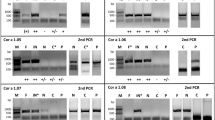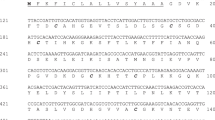Summary
We have found ragweed allergen Ra3 to be related to the type 1 copper proteins; it is most closely related to stellacyanin and basic blue protein. The type 1 copper proteins form a diverse group of proteins, most of which are involved in electron transport. However, key amino acids believed to be involved in copper binding are absent from the allergen sequence; thus, the allergen is not likely to be functionally related to the type 1 copper proteins. We have grouped these proteins into one superfamily and we depict the relationships among them by an evolutionary tree. As indicated by this tree, an ancient gene duplication resulted in the divergence of plastocyanin from the line leading to basic blue protein, stellacyanin, and allergen Ra3.
Similar content being viewed by others
References
Aikazyan, VT, nalbandyan RM (1981) Studies on plantacyanin. I. Distribution in the plant kingdom, subcellular localization and physicochemical properties. Biochim Biophys Acta 667: 421–432
Ambler RP (1968) Species differences in the amino acid sequences of bacterial proteins. In: Hawkes JG (ed) Chemotaxonomy and serotaxonomy. Academic Press, London New York, pp 57–64
Ambler RP (1971) Sequence data acquisition for the study of phylogeny. In: Recent developments in the chemical study of protein structures. INSERM, Paris, pp 289–305
Anderson JM, Andersson B (1982) The architecture of photosynthetic membranes: lateral and transverse organization. TIBS 7:288–292
Barker WC, Dayhoff MO (1983) Identifying unknown proteins. In: IEEE 1983 Proceedings of the Seventh Annual Symposium on Computer Applications in Medical Care. IEEE Computer Society Press, Silver Spring, Maryland, pp 584–588
Bergman C, Gandvik E-K, Nyman PO, Strid L (1977) The amino acid sequence of stellacyanin from the lacquer tree. Biochem Biophys Res Commun 77:1052–1059 and 79:1013 (erratum)
Brunori M, Greenwood C, Wilson MT (1974) A temperaturejump study of the reaction between azurin and cytochromec-551 fromPseudomonas aeruginosa. Biochem. J. 137:113–116
Chothia C, Lesk AM (1982) Evolution of proteins formed by β-sheets. J Mol Biol 160:309–323
Clarke AE, Knox RB (1978) Cell recognition in flowering plants. Q Rev Biol 53:3–28
Dayhoff MO (1976) The origin and evolution of protein superfamilies. Fed Proc 35:2132–2138
Dayhoff MO, Barker WC, Hunt LT, Schwartz RM (1979a) Protein superfamilies. In: Dayhoff MO (ed) Atlas of protein sequence and structure, vol 5, suppl 3. National Biomedical Research Foundation, Washington, DC, pp 9–24
Dayhoff MO, Schwartz RM, Orcutt BC (1979b) A model of evolutionary change in proteins. In: Dayhoff MO (ed) Atlas of protein sequence and structure, vol 5, suppl 3. National Biomedical Research Foundation, Washington, DC, pp 345–352
Dayhoff MO, Barker WC, Hunt LT (1983) Establishing homologies in protein sequences. Methods Enzymol 91:524–545
Dwulet FE, Putnam FW (1981) Internal duplication and evolution of human ceruloplasmin. Proc Natl Acad Sci USA 78:2805–2809
Fitch WM, Margoliash E (1967) Construction of phylogenetic trees. Science 155:279–284
Freeman HC (1979) Elegance in molecular design: the copper site of photosynthetic electron-transfer protein. J Proc R Soc NS Wales 112:45–62
George DG, Yeh L-SL, Barker WC (1983) Unexpected relationships between bacteriophage lambda hypothetical proteins and bacteriophage T4 tail-fiber proteins. Biochem Biophys Res Commun 115:1061–1068
Guss JM, Freeman HC (1983) Structure of oxidized poplar plastocyanin at 1.6 Å resolution. J Mol Biol 169:521–563
Hill HAO, Lee WK (1979) Investigation of the structure of the blue copper protein fromRhus vernicifera stellacyanin by1H nuclear magnetic resonance spectroscopy. J Inorg Biochem 11:101–113
Kelly J, Ambler RP (1974) The amino acid sequence of plastocyanin fromChlorella fusca. Biochem J 143:681–690
Kingston IB, Kingston BL, Putnam FW (1977) Chemical evidence that proteolytic cleavage causes the heterogeneity present in human ceruloplasmin preparations. Proc Natl Acad Sci USA 74:5377–5381
Klapper DG, Goodfriend L, Capra JD (1980) Amino acid sequence of ragweed allergen Ra3. Biochemistry 19:5729–5734
Knox RB, Willing RR, Ashford AE (1972) Role of pollen-wall proteins as recognition substances in interspecific incompatibility in poplars. Nature 237:381–383
Knox RB, Clarke A, Harrison S, Smith P, Marchalonis JJ (1976) Cell recognition in plants: determinants of the stigma surface and their pollen interactions. Proc Natl Acad Sci USA 73:2788–2792
Maizel JV Jr, Lenk RP (1981) Enhanced graphic matrix analysis of nucleic acid and protein sequences. Proc Natl Acad Sci USA 78:7665–7669
Murata M, Begg GS, Lambrou F, Leslie B, Simpson RJ, Freeman HC, Morgan FJ (1982) Amino acid sequence of a basic blue protein from cucumber seedlings. Proc Natl Acad Sci USA 79:6434–6437
Norris GE, Anderson BF, Baker EN (1983) Structure of azurin fromAlcaligenes denitrificans at 2.5 Å resolution. J Mol Biol 165:501–521
Orcutt BC, Dayhoff MO (1983) Protein identification system: methods of searching for similar sequences. In: IEEE 1983 Proceedings of the Seventh Annual Symposium on Computer Applications in Medical Care. IEEE Computer Society Press, Silver Spring, Maryland, pp 579–581
Petersen FP (1983) Pollen proteins. In: Jensen U, Fairbrothers DE (eds) Proteins and nucleic acids in plant systematics. Springer-Verlag, Berlin Heidelberg, pp 255–272
Ramshaw JAM (1982) Structures of plant proteins. In: Boulter D, Parthier B (eds) Nucleic acids and proteins in plants I. Springer-Verlag, Berlin Heidelberg New York, pp 229–290
Ramshaw JAM, Scawen MD, Boulter D (1974) The amino acid sequence of plastocyanin fromVicia faba L (broad bean). Biochem J 141:835–843
Ramshaw JAM, Scawen MD, Jones EA, Brown RH, Boulter D (1976) The amino acid sequence of plastocyanin fromLactuca sativa (lettuce). Phytochemistry 15:1199–1202
Ryden L (1982) Model of the active site in the blue oxidases based on the ceruloplasmin-plastocyanin homology. Proc Natl Acad Sci USA 79:6767–6771
Ryden L, Lundgren J-O (1976) Homology relationships among the small blue proteins. Nature 261:344–346
Ryden L, Lundgren J-O (1979) On the evolution of blue proteins. Biochimie 61:781–790
Ryden L, Lundgren J-O (1980) The relationship of the small blue proteins with the copper-containing oxidases. In: Peeters H (ed) Protides of the Biological Fluids, Proceedings of the Twenty-eighth Colloquium, Pergamon Press, Oxford, pp 87–90
Sakurai T, Okamoto H, Kawahara K, Nakahara A (1982) Some properties of a blue copper protein «plantacyanin» from cucumber peel. FEBS Lett 147:220–224
Scawen MD, Boulter D (1974) The amino acid sequence of plastocyanin fromCucurbita pepo L (vegetable marrow). Biochem J 143:257–264
Schwartz RM, Dayhoff MO (1978) Origins of prokaryotes, eukaryotes, mitochondria, and chloroplasts. Science 199:395–403
Schwartz RM, Dayhoff MO (1979a) Other electron transport proteins. In: Dayhoff MO (ed) Atlas of protein sequence and structure, vol 5, suppl 3. National Biomedical Research Foundation, Washington, DC, pp 45–57
Schwartz RM, Dayhoff MO (1979b) Matrices for detecting distant relationships. In: Dayhoff MO (ed) Atlas of protein sequence and structure, vol 5, suppl 3. National Biomedical Research Foundation, Washington, DC, pp 353–358
Takahashi N, Ortel TL, Putnam FW (1984) Single-chain structure of human ceruloplasmin: the complete amino acid sequence of the whole molecule. Proc Natl Acad Sci USA 81:390–394
Van Sumere CF, Albrecht J, Dedonder A, De Pooter H, Pe I (1975) Plant proteins and phenolics. In: Harborne JB, Van Sumere CF (eds) The chemistry and biochemistry of plant proteins. Academic Press, London New York San Francisco, pp 211–264
Author information
Authors and Affiliations
Additional information
This paper is dedicated to the memory of Professor Margaret O. Dayhoff, whose contributions to the study of protein evolution made this investigation possible
Rights and permissions
About this article
Cite this article
Hunt, L.T., George, D.G. & Yeh, LS.L. Ragweed allergen Ra3: Relationship to some type 1 copper-binding proteins. J Mol Evol 21, 126–132 (1985). https://doi.org/10.1007/BF02100086
Received:
Revised:
Issue Date:
DOI: https://doi.org/10.1007/BF02100086




